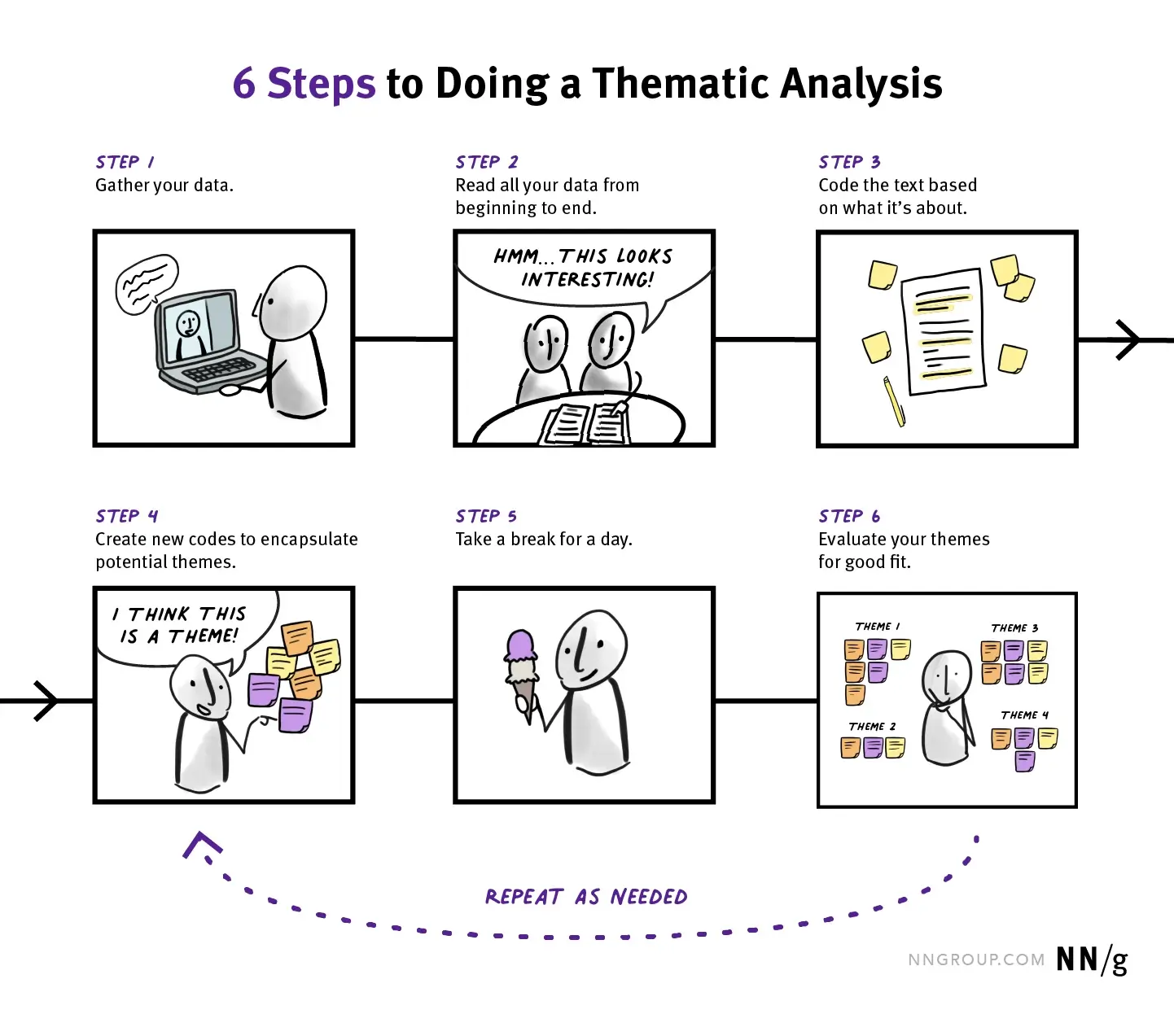What is thematic analysis?
Thematic analysis is used to analyze qualitative data – that is, data relating to opinions, thoughts, feelings and other descriptive information. It’s become increasingly popular in social sciences research, as it allows researchers to look at a data set containing multiple qualitative sources and pull out the broad themes running through the entire data set.
That data might consist of articles, diaries, blog posts, interview transcripts, academic research, web pages, social media and even audio and video files. They are put through data analysis as a group, with researchers seeking to identify patterns running through the corpus as a whole.
Free eBook: The qualitative research design handbook
Thematic analysis steps

Image source: https://www.nngroup.com/articles/thematic-analysis/
While there are many types of thematic analysis, the thematic analysis process can be generalized into six steps. Thematic analysis involves initial analysis, coding data, identifying themes and reporting on the findings.
- Familiarization – During the first stage of thematic analysis, the research teams or researchers become familiar with the dataset. This may involve reading and re-reading, and even transcribing the data. Researchers may note down initial thoughts about the potential themes they perceive in the data, which can be the starting point for assigning initial codes.
- Coding – Codes in thematic analysis are the method researchers use to identify the ideas and topics in their data and refer to them quickly and easily. Codes can be assigned to snippets of text data or clips from videos and audio files. Depending on the type of thematic analysis used, this can be done with a systematic and rigorous approach, or in a more intuitive manner.
- Identifying theme – Themes are the overarching ideas and subject areas within the corpus of research data. Researchers can identify themes by collating together the results of the coding process, generating themes that tie together the identified codes into groups according to their meaning or subject matter.
- Reviewing themes – Once the themes have been defined, the researchers check back to see how well the themes support the coded data extracts. At this stage they may start to organize the themes into a map, or early theoretical framework.
- Defining and naming themes – As researchers spend more time reviewing the themes, they begin to define them more precisely, giving them names. Themes are different from codes, because they capture patterns in the data rather than just topics, and they relate directly to the research question.
- Writing up – At this stage, researchers begin to develop the final report, which offers a comprehensive summary of the codes and themes, extracts from the original data that illustrate the findings, and any other data relevant to the analysis. The final report may include a literature review citing other previous research and the observations that helped frame the research question. It can also suggest areas for future research the themes support, and which have come to light during the research process.
Another step which precedes all of these is data collection. Common to almost all forms of qualitative analysis, data collection means bringing together the materials that will be part of the data set, either by finding secondary data or generating first-party data through interviews, surveys and other qualitative methods.
Types of thematic analysis
There are various thematic analysis approaches currently in use. For the most part, they can be viewed as a continuum between two different ideologies. Reflexive thematic analysis (RTA) sits at one end of the continuum of thematic analysis methods. At the other end is code reliability analysis.
Code reliability analysis emphasizes the importance of the codes given to themes in the research data being as accurate as possible. It takes a technical or pragmatic view, and places value on codes being replicable between different researchers during the coding process. Codes are based on domain summaries, which often link back to the questions in a structured research interview.
Researchers using a code reliability approach may use a codebook. A codebook is a detailed list of codes and their definitions, with exclusions and examples of how the codes should be applied.
Reflexive thematic analysis was developed by Braun & Clarke in 2006 for use in the psychology field. In contrast to code reliability analysis, it isn’t concerned with consistent codes that are agreed between researchers. Instead, it acknowledges and finds value in each researcher’s interpretation of the thematic content and how it influences the coding process. The codes they assign are specific to them and exist within a unique context that is made up of:
- The data set
- The assumptions made during the setup of the analysis process
- The researcher’s skills and resources
This doesn’t mean that reflexive thematic analysis should be unintelligible to anyone other than the researcher. It means that the researcher’s personal subjectivity and uniqueness is made part of the process, and is expected to have an influence on the findings. Reflexive thematic analysis is a flexible method, and initial codes may change during the process as the researcher’s understanding evolves.
Reflexive thematic analysis is an inductive approach to qualitative research. With an inductive approach, the final analysis is based entirely on the data set itself, rather than from any preconceived themes or structures from the research team.

Image source: https://delvetool.com/blog/thematicanalysis
Thematic analysis vs other qualitative research methods
Thematic analysis sits within a whole range of qualitative analysis methods which can be applied to social sciences, psychology and market research data.
- Thematic analysis vs comparative analysis – Comparative analysis and thematic analysis are closely related, since they both look at relationships between multiple data sources. Comparative analysis is a form of qualitative research that works with a smaller number of data sources. It focuses on causal relationships between events and outcomes in different cases, rather than on defining themes.
- Thematic analysis vs discourse analysis – Unlike discourse analysis, which is a type of qualitative research that focuses on spoken or written conversational language, thematic analysis is much more broad in scope, covering many kinds of qualitative data.
- Thematic analysis vs narrative analysis – Narrative analysis works with stories – it aims to keep information in a narrative structure, rather than allowing it to be fragmented, and often to study the stories from participants’ lives. Thematic analysis can break narratives up as it allocates codes to different parts of a data source, meaning that the narrative context might be lost and even that researchers might miss nuanced data.
- Thematic analysis vs content analysis – Both content analysis and thematic analysis use data coding and themes to find patterns in data. However, thematic analysis is always qualitative, but researchers agree there can be quantitative and qualitative content analysis, with numerical approaches to the frequency of codes in content analysis data.
Thematic analysis advantages and disadvantages
Like any kind of qualitative analysis, thematic analysis has strengths and weaknesses. Whether it’s right for you and your research project will depend on your priorities and preferences.
Thematic analysis advantages
- Easy to learn – Whether done manually or assisted by technology, the thematic analysis process is easy to understand and conduct, without the need for advanced statistical knowledge
- Flexible – Thematic analysis allows qualitative researchers flexibility throughout the process, particularly if they opt for reflexive thematic analysis
- Broadly applicable – Thematic analysis can be used to address a wide range of research questions.
Thematic analysis – the cons
As well as the benefits, there are some disadvantages thematic analysis brings up.
- Broad scope – In identifying patterns on a broad scale, researchers may become overwhelmed with the volume of potential themes, and miss outlier topics and more nuanced data that is important to the research question.
- Themes or codes? – It can be difficult for novice researchers to feel confident about the difference between themes and codes
- Language barriers – Thematic analysis relies on language-based codes that may be difficult to apply in multilingual data sets, especially if the researcher and / or research team only speaks one language.
How can you use thematic analysis for business research?
Thematic analysis, and other forms of qualitative research, are highly valuable to businesses who want to develop a deeper understanding of the people they serve, as well as the people they employ. Thematic analysis can help your business get to the ‘why’ behind the numerical information you get from quantitative research.
An easy way to think about the interplay between qualitative data and quantitative data is to consider product reviews. These typically include quantitative data in the form of scores (like ratings of up to 5 stars) plus the explanation of the score written in a customer’s own words. The word part is the qualitative data. The scores can tell you what is happening – lots of 3 star reviews indicate there’s some room for improvement for example – but you need the addition of the qualitative data, the review itself, to find out what’s going on.
Qualitative data is rich in information but hard to process manually. To do qualitative research at scale, you need methods like thematic analysis to get to the essence of what people think and feel without having to read and remember every single comment.
Qualitative analysis is one of the ways businesses are borrowing from the world of academic research, notably social sciences, statistical data analysis and psychology, to gain an advantage in their markets.
Analyzing themes across video, text, audio and more
Carrying out thematic analysis manually may be time-consuming and painstaking work, even with a large research team. Fortunately, machine learning and other technologies are now being applied to data analysis of all kinds, including thematic analysis, taking the manual work out of some of the more laborious thematic analysis steps.
The latest iterations of machine learning tools are able not only to analyze text data, but to perform efficient analysis of video and audio files, matching the qualitative coding and even helping build out the thematic map, while respecting the researcher’s theoretical commitments and research design.
Free eBook: The qualitative research design handbook